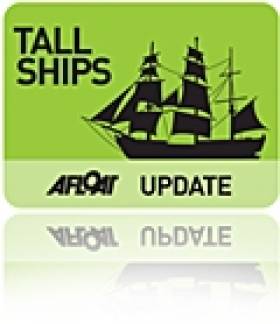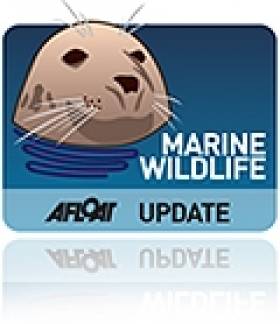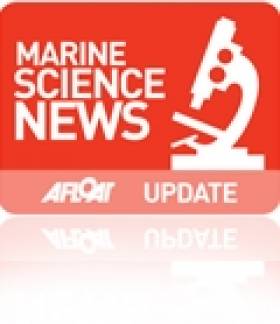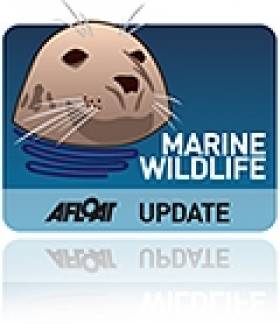Displaying items by tag: Dingle
#MarineNotice - The latest Marine Notice from the Department of Transport, Tourism and Sport (DTTAS) advises of a previously uncharted rock outside the approaches to Dingle's Fishery Harbour Centre.
The rocky outcrop or shoal was identified by the Geological Survey of Ireland (GSI) vessel RV Geo recently, and appears to be part of the shoreward extension of the Crow and Colleen-oge Rocks.
Full details of its depth and position are included in Marine Notice No 37 of 2013, a PDF of which is available to read or download HERE.
In other news, the Marine Institute is conducting a pipeline and platform superstructure (or 'jacket') survey in the Celtic Sea.
The survey, on behalf of Kinsale Energy Limited, was scheduled to commence last Monday 22 July and will continue till Friday 30 August.
Works are being conducted by the MV Granuaile (Call sign EIPT) which is carrying out underwater operations using a remote operated vehicle (ROV) making 0.4 to 0.7 knots over the ground. The vessel is listening on VHF Channel 16 throughout the project.
All vessels, particularly those engaged in fishing, are requested to give the MC Granuaile a wide berth and keep a sharp lookout in the relevant areas. Full details of co-ordinates are included in Marine Notice No 36 of 2013.
Celtic Mist in Dun Laoghaire Ready For Gathering Cruise
#CelticMist - The Irish Whale and Dolphin Group's (IWDG) research yacht Celtic Mist is currently docked in Dun Laoghaire awaiting the start of The Gathering Cruise around Ireland.
As previously reported on Afloat.ie, the 19-day event will see some 100 cruising boats proceed along the east and south coasts of Ireland from Dublin to Cork and Kerry.
Along the way they will be recording any sightings of whales or dolphins along the way using forms supplied by the IWDG.
Celtic Mist will join the flotilla as it departs Dun Laoghaire Harbour on 18 July headed for Kinsale on 24 July, and a second leg from Kinsale to Dingle from 25 July to 1 August.
And the IWDG is currently offering places on board to all members for both week-long legs of the cruise.
The vessel has eight berths that will comfortably sleep a team of one skipper and seven crew - indeed, anyone taking up this offer will be expected to prepare meals and perform other sailing duties!
For more details on how to join The Gathering Cruise on board Celtic Mist, see the IWDG website HERE.
In the meantime, Celtic Mist is offering all IWDG members a chance to sail on day trips from Dun Laoghaire this week - email [email protected] for details.
Road To Dingle Gets a Welcome Upgrade
#Dingle - The Minister for Transport, Tourism & Sport has officially opened a newly upgraded section of the main road to one of Ireland’s most popular coastal towns.
Minister Leo Varadkar opened the new section of the N86 road outside Annascaul which lies on the main route from Tralee to Dingle, and which is used by thousands of local residents and thousands more tourists every year.
The project cost around €9 million and was funded by the Department of Transport, Tourism & Sport. It was overseen by the National Roads Authority (NRA) and Kerry County Council and was completed in around 16 months.
Speaking at the launch, Minister Varadkar said: "This is an important project for West Kerry and the whole county, and will make a big difference to journeys in the area.
"But it has also national significance, as thousands of tourists travel along the N86 every year in order to reach Dingle, one of our premier tourism destinations."
He added: “Although the old N86 had its charms, it was also very narrow, and the stretch which we have upgraded had a number of dangerous junctions leading on to side roads. These have now been replaced and will make a big difference to safety levels.
"The new road is wider at 3 metres, and also provides a hard shoulder in each direction. I’m also very pleased that we have been able to offer cycle and pedestrian facilities along this stretch.”
In the longer term, the NRA plans to upgrade the entire length of the N86 between Dingle in the west of the peninsula, and Camp on the northern side.
The plan is to develop the 27km project as one of four Tourist Route Pilot Schemes, including cycle schemes and pedestrian access.
Similar schemes have already opened along the N59 near Clifden, Co Galway, the N59 at Kilbride, Co Mayo and the N56 at Glenties, Co. Donegal.
The proposal for the N86 would considerably improve safety levels and journey times in West Kerry, and improve road surfaces in the villages of Lispole, Annascaul and Camp on the Dingle Peninsula.
#D2D – The Round Ireland Race of 1992, like all stagings of the classic circuit, was one of mixed memories. It started in sunshine with a fair wind which carried us all the way to the Fastnet. But that wind stayed very determinedly between north and northeast, so we knew there'd be windward work round the Kerry coast.
In fact, we were on the wind until Mayo. Then it drew eventually from the southwest and there was the usual scamper across Donegal Bay and around Tory Island. Then the breeze was all over the place down the Irish Sea until we were sitting nicely, breeze off the land, aroma of the Wicklow countryside to be savoured and all that, finish line nicely in sight......and suddenly we were in a flat spot which lasted just long enough to turn a close class win into second in class by 17 minutes.
So all we really remember of the race of '92 is that sweetness of the summer evening made sour by the breeze turning off. It takes a real effort to remember that, three day earlier, we'd actually been having a right pasting off the Kerry coast. For sure, we'd known we'd have headwinds past the Blaskets. But the forecast had missed out on a deepening low to the east. So much so, in fact, that the Irish Sailing Association subsequently launched an informal enquiry into why the severe rise in the wind strength had gone largely unanticipated, as there were wholesale retirals, with much damage.
With hindsight, of course, it was there to be seen - we just didn't want to see it. We may have approached the Fastnet on a reach in sunshine. But there was a harshness to the evening, and any God's amount of warning clouds at a high level, to tell us that this wasn't going to be a straightforward bit of windward work on a summer's night. And even on a gentle summer's night, the Atlantic off Kerry can be a rumbly place. So when it came in a real stinker between north and northeast, it was boat-breaking stuff, with several ports in West Cork and Kerry acquiring their quota of retirals.

South Pacific? No, just Dingle as it can be when, as was happening in this case, most of the rest of Ireland was in heavy rain. Photo: W M Nixon
One such was the Sigma 41 Koala (Peter Cullen and Martin Crotty), which split her mainsail and did well to get to Dingle. As they put themselves together again and breathed in that Dingle air with its unmistakable sense of being in the far west and everything well with the world, they got to thinking how it would just be perfect if the race had just been to Dingle, instead of battering all the way round Ireland simply to end up back where they started from.
That's what it is with Dingle. It's one of those places that everybody thinks they're really the first ever to discover properly and understand and appreciate. It is unique, there's no doubt of that. But when you sail in there and get enveloped in its hospitable warmth, you soon think it's uniquely unique. So naturally the crew of Koala got to thinking about a sort of Round Ireland Lite, a race from the east coast finishing at Dingle.

It took Dingle to show just how effective a combined fishing/sailing port can be. It's a favoured destination for cruising boats, yet it continues to have an impressive tally of fish landings. Photo: W M Nixon
It would have been a grand thing to talk about in the convenient first stop at Flahive's before moving on to one of the excellent Dingle restaurants. And for most crews, that would have been the end of it. But the crew of Koala were made of sterner stuff. They sailed home eventually, and they just wouldn't let go of the idea of a biennial race to Dingle alternating with the round Ireland. If they were going to do it, 'twas best 'twere done soonest. So 20 years ago, in 1993, Martin Crotty on behalf of the National YC organised the first 280 mile Dun Laoghaire to Dingle Race, Peter Cullen with his jelly bean manufacturing company put up the sponsorship, and one of the best events in the Irish sailing calendar became an instant success.
It's on again next Friday, June 7th, the 11th D2D, starting before the weekend to facilitate the boats using it to get to the ICRA Nationals in Tralee Bay from June 13th. And there's an excellent line-up, an interesting balance of 22 good boats which – considering the times we live in – is a fine turnout, particularly when we look at the calibre of the boats involved.
Fond memories of the great Denis Doyle and his enthusiasm for every offshore race going are evoked by the Cork presence of Anthony and Peter O'Leary's Ker 39 Antix, briskly back to Ireland from the RORC Vice Commodore's campaigning in the English Channel series in order to race to Kerry, and make the lineup in Tralee Bay.

Anthony O'Leary (Royal Cork) and Peter O'Leary (Baltimore SC) will be racing the busy Antix in the biennial D2D next Friday. Photo: Paul Wyeth
Antix has been in the frame if not on the podium in this year's RORC racing, so her presence sets a benchmark. Defending champion in the D2D is the Galway Reflex 38, curently sailing as Discover Ireland/The Gathering. She didn't exactly cover herself in glory at last weekend's Scottish series, but then she'd all the disadvantage of being the highest rated boat in IRC 2, which made her an easy target, and the offshore scene seems to suit her better.
Certainly the Dingle Race is important to Aodhan Fitzgerald's crew as a Fastnet qualifier. With the absence of any seriously large biggy to challenge the course record set by Mick Cotter's 77ft Whisper two races ago, there's a possibility that Antix and Discover Ireland will be battling for line honours, though that is an outcome which could well be upturned by the presence of boats like the Farr 42 Wow (George Sisk RIYC), and the three Beneteau First 44.7s - Adelie (Peter Hall NYC), Legally Blonde (Cathal Drohan & Paul Egan RStGYC), and White Tiger (Anthony O'Brien, Kinsale).
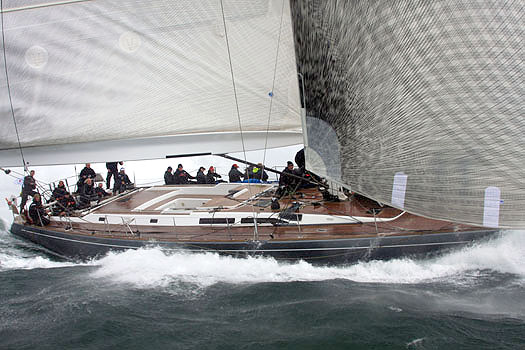
Mick Cotter's 77ft Whisper almost broke the 24-hour barrier for the record for the Dingle Race in the race of 2009. Photo: David O'Brien
Although the Irish Sea's champion J/109 Sgrech (Stephen Tudor) won't be involved, there are four of these useful all-rounders taking part, and Liam Shanahan's Ruth from the National YC was showing promising speed in the Scottish Series.
And a seriously interesting entry from further down the size scale is Paul O'Higgins' Corby 33 Rockabill V from Dun Laoghaire, which has an enviable racing record. The Corby 33 is more than sparse enough for most folk for a night or two at sea. Add in the increasing demands of the seaways as you get further west, and you have a challenging proposition which nevertheless could serve up a race win if conditions fall the right way. The smart money might just be on Rockabill V.

Paul O'Higgins' Corby 33 Rockabill V offers only the most austere comfort for offshore sailing, but in the right conditions her proven racing record might find itself augmented by the Dingle title.
National YC/Skellig Hotel Dun Laoghaire to Dingle Race 2013 Entry List
| Boat Name | Sail no | Model | Sun Division | Name | Surname | Club | IRC TCC |
|---|---|---|---|---|---|---|---|
| Antix | IRL 3939 | Ker 39 | Racing | Anthony / Peter | O'Leary | BSC/ RCYC | 1.136 |
| Joker II | IRL 1206 | J109 | Racing | John | Maybury | RIYC | 1.017 |
| Blue Eyes | IRL 9849 | Elan 340 | 2-handed | Colm | Buckley | HYC | 0.983 |
| Lisador | IRL 1295 | Dehler 36 | Racing | Henry | Hogg | Garrykennedy SC | 0.958 |
| Ruth | IRL 1383 | J109 | Racing | Liam | Shanahan | NYC | 1.02 |
| Jedi | IRL 8088 | J109 | Racing | Andrew | Sarrath | RIYC | 1018 |
| Spindrift | IRL 1503 | HR34 | Cruising | David | Kelly | Waterford SC | 0.938 |
| Polished Manx | GER8666 | Sigma 33 | Racing | Kuba | Szymanski | DBYC | 0.898 |
| Discover Ireland | IRL 7386 | Reflex 38 | Racing | Adhan | Fitzgerald | GBSC | 1.055 |
| Black jack | IRL 1988 | Pocock 38 | 2-handed | Peter/ Darren | Coad/Nicholson | WHSC | 0.934 |
| Conundrum | IRL 3503 | Hanse | Cruising | Michael | Pomeroy | RStGYC | 0.968 |
| Amazing Grace | IRL1966 | Oyster 37 | Racing | Brian | O'Sullivan | TBSC | 0.931 |
| Rockabill V | IRL 3307 | Corby 33 | Racing | Paul | O'Higgins | NYC/IRIYC | 1.041 |
| Aquelina | IRL 1281 | J-122 | Racing | James S | Tyrrell | ASC | 1.084 |
| Chancer | IRL 1583 | Elan 40 | Racing | Brian | Carroll | 1.027 | |
| White Tiger | IRL 4470 | Beneteau First 44.7 | Racing | Anthony | O'Brien | KYC | 1.113 |
| Mojito | GBR9047R | J109 | Racing | Peter | Dunlop | CHPwllheli SC | 1.014 |
| Ocean Tango | GBR6848T | Dehler34 | 2-Handed | Robert | Floate | DMYC/ WSC | 0.928 |
| Legally Blonde | IRL 3175 | Beneteau First 44.7 | Racing | Cathal/Paul | Drohan/Egan | RStGYC | 0.952 |
| Lulla Belle | IRL 3607 | Beneteau First 36.7 | 2-Handed | Liam/Brian | Coyne/Flahive | NYC | 1.001 |
| Wow | IRL 4208 | Farr42 | Racing | George | Sisk | RIYC | 1.144 |
| Adelie | IRL 9631 | Beneteau First 44.7 | Racing | Peter | Hall | NYC | 1.003 |
Comment on this story?
We'd like to hear from you! Leave a message in the box below or email William Nixon directly on [email protected]
WM Nixon's Saturday Sailing blog appears every Saturday on Afloat.ie
Follow us on twitter @afloatmagazine and on our Afloat facebook page
Dingle's Fungie May Have Come From British Dolphinarium
#Fungie - An Irish marine expert suspects that Dingle's most famous resident may be an escapee from a British dolphinarium.
Dingle Oceanworld director Kevin Flannery told the Irish Independent that Fungie the dolphin could have slipped through the sluice gates of any one of a number of dolphinariums on the south coast of England amid "huge objections to holding marine animals in captivity".
As previously reported on Afloat.ie, the male bottlenose dolphin appeared out of nowhere in Dingle's harbour in 1983 and has made his home there ever since.
In the three decades from then he has been credited with having "rescued" the village as his frolics brings countless tourists to the peninsula every year, as Flannery told the Irish Examiner.
This week's Féile na Bealtaine in Dingle celebrates the 30th anniversary of the arrival of the Kerry village's cetacean mascot, and many visitors are expected to line up for boat trips out of the harbour to meet him face to face.
While the Irish Whale and Dolphin Group (IWDG) doesn't recommend swimming with a wild dolphin such as Fungie, the group's Nick Massett describes him as "friendly, intelligent, and very aware of where people [are] in the water".
Among the festival activities this week will be a film screening and exhibits paying tribute to Ireland's own 'Flipper'.
Féile na Bealtaine runs from 2-6 May with events throughout the Dingle Peninsula.
#MarineScience - An American university is teaming up with marine experts in Dingle to offer advanced marine biology classes.
As the Fairfield Sun reports, the biology department at Sacred Heart University in Connecticut is collaborating with scientists and staff at the Dingle Oceanworld Aquarium to offer the advanced classes to undergraduate and postgraduate students alike, beginning this May.
It's expected that the Coastal Study Centre programme will eventually provide both semester-long and short courses to take advantage of the aquarium's advanced research facilities, and will also accommodate students doing relevant thesis field work.
“Very few primarily undergraduate institutions have as strong a coastal focus as Sacred Heart does, which is only enhanced by our proximity to Long Island Sound,” said John Rapaglia, assistant professor of biology at Sacred Heart.
“Dingle Harbour’s semi-rural to rural location creates a nice juxtaposition to the highly urbanised Long Island Sound.”
Sacred Heart already has an established campus in the Kerry Gaeltacht town where students can take classes on Irish and Celtic history and heritage among other subjects.
The Fairfield Sun has more on the story HERE.
Twitter Fears Unfounded as Dingle's Fungie is Alive and Flipping
#FUNGIE - He was the subject of rumours of his demise earlier this week - but the people of Dingle say their most famous resident, Fungie the dolphin, is alive and flipping.
A spokeswoman for Dingle Dolphin Boat Tours confirmed to The Daily Edge that Fungie is "definitely alive", and that no dolphin remains had washed up on the beach, as had been claimed on Twitter last Monday morning.
The Co Kerry fishing village is celebrating 30 years of the bottlenose dolphin's residency in its harbour. It's unclear exactly how old Fungie is, but it's presumed he was born in the mid 1970s.
Irish Central has more on the story HERE.
Thirty Years of Fungie's Frolics in Dingle
#FUNGIE - A new video posted to YouTube celebrates 30 years of Fungie the dolphin in Dingle.
The male bottlenose dolphin appeared from out of nowhere in the Co Kerry fishing village in 1983 and soon made it his home, quickly becoming an integral part of the local community.
Since his arrival Fungie has made friends and warmed hearts with people both local and across the world, such as Dutch couple Jeannine Masset and Rudi Schamhart who have been meeting him for more than 20 years.
Meanwhile, locals hope that new measures for harbour users proposed earlier this year won't bring an end to boat trips to meet Dingle's most famous resident.
Marine Notice: Construction Work in Dingle Harbour
#MARINE WARNING - The latest Marine Notice from the Department of Transport, Tourism and Sport (DTTAS) advises on construction works at An Daingean Fishery Harbour Centre in Co Kerry scheduled to commence today 3 September 2012, weather permitting.
The works will take place at the mouth of Dingle Harbour, to the south east of Flaherty Point (co-ordinates: 52 07.235’ North, 010 15.711’ West) and will involve the installation of a new navigation beacon, five metres in height.
The works are being advanced by the Marine Engineering Division of the Department of Agriculture, Food and the Marine. The construction will involve use of a work vessel 20m × 7m in size carrying civil engineering plant and machinery, as well as other smaller work vessels and platforms. The work vessel will display the relevant day signals and navigation lights in accordance with the Collision Regulations.
For safety reasons, mariners are requested to proceed slowly and with caution in the approach to the entrance to Dingle Harbour and to give the works a wide berth. Wave-wash from vessels should be avoided.
These works are expected to be on-going until the end of October 2012, weather permitting.
Dancing Dolphins Surprise Researchers Off Donegal
#MARINE WILDLIFE - Marine researchers off the coast of Donegal were recently treated to a rare dolphin dance by a 50-strong pod, as IrishCentral reports.
The video above captures the same pod witnessed by researchers with the Irish Basking Shark Project, who were in the area off Inishowen to observe basking sharks in the coastal waters when they were surprised by the gregarious dolphin congregation.
A spokesperson for the project confirmed to IrishCentral that such large groupings of dolphins are unusual for the area, which has welcomed more than its fair share of large marine wildlife over recent months.
As previously reported on Afloat.ie, one of the first confirmed sightings of killer whales on the Irish coastline was recorded earlier this summer when a family of orcas from the Scottish Hebrides visited the same waters at the mouth of Lough Swilly.
Meanwhile, WorldIrish reports on the heartwarming tale of a Dutch couple who have bonded with Dingle's most famous non-human resident, Fungie the dolphin.
Jeannine Masset and Rudi Schamhart, who now live in Annascaul, have visited the friendly cetacean for 21 years, and their connection has inspired a fanpage on Facebook that has received responses from Fungie fans around the world.
"Fungie has enriched our lives and we want to give something back to him by offering our friendship and companionship to him," said Jeannine, "and he lets us know over and over again that he really appreciates it."



























